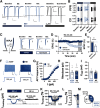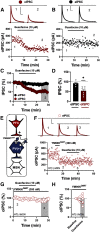Noradrenergic Signaling Disengages Feedforward Transmission in the Nucleus Accumbens Shell
- PMID: 33737458
- PMCID: PMC8084318
- DOI: 10.1523/JNEUROSCI.2420-20.2021
Noradrenergic Signaling Disengages Feedforward Transmission in the Nucleus Accumbens Shell
Abstract
The nucleus accumbens shell (NAcSh) receives extensive monoaminergic input from multiple midbrain structures. However, little is known how norepinephrine (NE) modulates NAc circuit dynamics. Using a dynamic electrophysiological approach with optogenetics, pharmacology, and drugs acutely restricted by tethering (DART), we explored microcircuit-specific neuromodulatory mechanisms recruited by NE signaling in the NAcSh of parvalbumin (PV)-specific reporter mice. Surprisingly, NE had little direct effect on modulation of synaptic input at medium spiny projection neurons (MSNs). In contrast, we report that NE transmission selectively modulates glutamatergic synapses onto PV-expressing fast-spiking interneurons (PV-INs) by recruiting postsynaptically-localized α2-adrenergic receptors (ARs). The synaptic effects of α2-AR activity decrease PV-IN-dependent feedforward inhibition onto MSNs evoked via optogenetic stimulation of cortical afferents to the NAcSh. These findings provide insight into a new circuit motif in which NE has a privileged line of communication to tune feedforward inhibition in the NAcSh.SIGNIFICANCE STATEMENT The nucleus accumbens (NAc) directs reward-related motivational output by integrating glutamatergic input with diverse neuromodulatory input from monoamine centers. The present study reveals a synapse-specific regulatory mechanism recruited by norepinephrine (NE) signaling within parvalbumin-expressing interneuron (PV-IN) feedforward inhibitory microcircuits. PV-IN-mediated feedforward inhibition in the NAc is instrumental in coordinating NAc output by synchronizing the activity of medium spiny projection neurons (MSNs). By negatively regulating glutamatergic transmission onto PV-INs via α2-adrenergic receptors (ARs), NE diminishes feedforward inhibition onto MSNs to promote NAc output. These findings elucidate previously unknown microcircuit mechanisms recruited by the historically overlooked NE system in the NAc.
Keywords: adrenergic receptor; feedforward inhibition; neorepinephrine; nucleus accumbens; parvalbumin interneurons; prefrontal cortex.
Copyright © 2021 the authors.
Figures





Similar articles
-
Heterosynaptic GABAB Receptor Function within Feedforward Microcircuits Gates Glutamatergic Transmission in the Nucleus Accumbens Core.J Neurosci. 2019 Nov 20;39(47):9277-9293. doi: 10.1523/JNEUROSCI.1395-19.2019. Epub 2019 Oct 2. J Neurosci. 2019. PMID: 31578230 Free PMC article.
-
Hippocampal-Evoked Feedforward Inhibition in the Nucleus Accumbens.J Neurosci. 2018 Oct 17;38(42):9091-9104. doi: 10.1523/JNEUROSCI.1971-18.2018. Epub 2018 Sep 5. J Neurosci. 2018. PMID: 30185462 Free PMC article.
-
Accumbal Histamine Signaling Engages Discrete Interneuron Microcircuits.Biol Psychiatry. 2023 Jun 1;93(11):1041-1052. doi: 10.1016/j.biopsych.2021.10.004. Epub 2021 Oct 16. Biol Psychiatry. 2023. PMID: 34953589 Free PMC article.
-
Cocaine-induced projection-specific and cell type-specific adaptations in the nucleus accumbens.Mol Psychiatry. 2022 Jan;27(1):669-686. doi: 10.1038/s41380-021-01112-2. Epub 2021 May 7. Mol Psychiatry. 2022. PMID: 33963288 Free PMC article. Review.
-
Interneurons. Fast-spiking, parvalbumin⁺ GABAergic interneurons: from cellular design to microcircuit function.Science. 2014 Aug 1;345(6196):1255263. doi: 10.1126/science.1255263. Epub 2014 Jul 31. Science. 2014. PMID: 25082707 Review.
Cited by
-
The nucleus accumbens in reward and aversion processing: insights and implications.Front Behav Neurosci. 2024 Aug 9;18:1420028. doi: 10.3389/fnbeh.2024.1420028. eCollection 2024. Front Behav Neurosci. 2024. PMID: 39184934 Free PMC article. Review.
-
Synaptic and cellular endocannabinoid signaling mechanisms regulate stress-induced plasticity of nucleus accumbens somatostatin neurons.Proc Natl Acad Sci U S A. 2023 Aug 22;120(34):e2300585120. doi: 10.1073/pnas.2300585120. Epub 2023 Aug 17. Proc Natl Acad Sci U S A. 2023. PMID: 37590414 Free PMC article.
-
Behavioral and neurochemical interactions of the tricyclic antidepressant drug desipramine with L-DOPA in 6-OHDA-lesioned rats. Implications for motor and psychiatric functions in Parkinson's disease.Psychopharmacology (Berl). 2022 Nov;239(11):3633-3656. doi: 10.1007/s00213-022-06238-x. Epub 2022 Sep 30. Psychopharmacology (Berl). 2022. PMID: 36178508 Free PMC article.
-
A Predictive Coding Framework for Understanding Major Depression.Front Hum Neurosci. 2022 Mar 3;16:787495. doi: 10.3389/fnhum.2022.787495. eCollection 2022. Front Hum Neurosci. 2022. PMID: 35308621 Free PMC article. Review.
-
Kappa opioid receptor modulation of excitatory drive onto nucleus accumbens fast-spiking interneurons.Neuropsychopharmacology. 2021 Dec;46(13):2340-2349. doi: 10.1038/s41386-021-01146-8. Epub 2021 Aug 16. Neuropsychopharmacology. 2021. PMID: 34400782 Free PMC article.
References
Publication types
MeSH terms
Substances
Grants and funding
LinkOut - more resources
Full Text Sources
Other Literature Sources
Molecular Biology Databases
Research Materials
